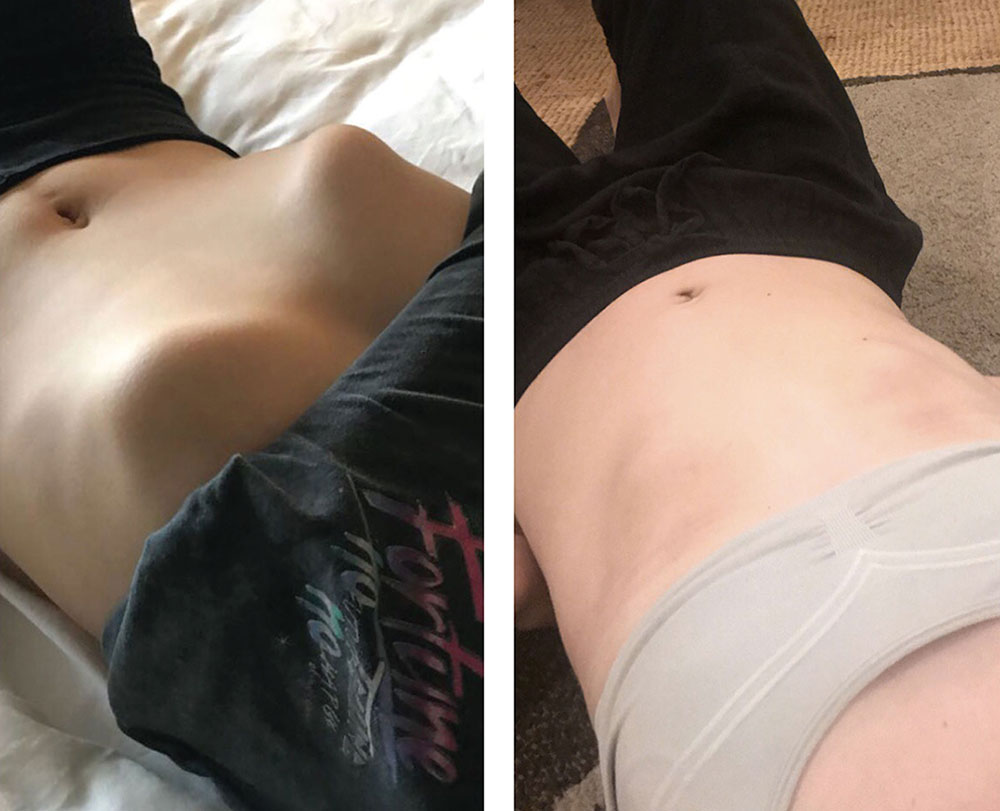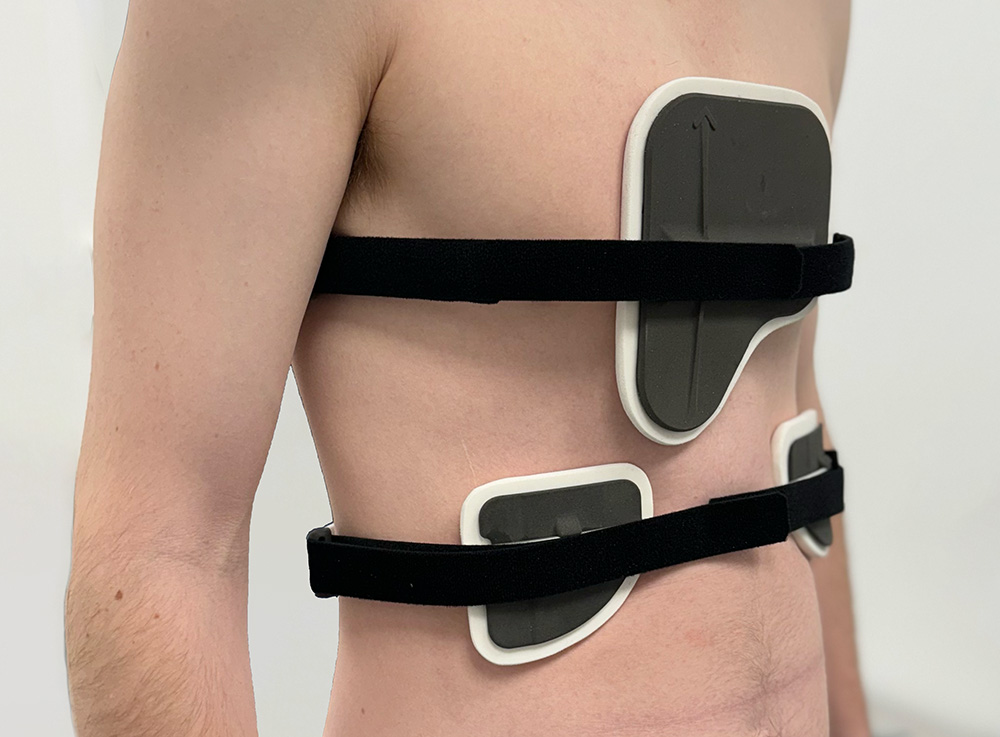Rib flaring, or rib flare, is a condition where the ribs stick out, causing the chest to protrude outward. This can cause a noticeable bulge on the sides of the chest and result in an abnormal chest shape. It is often an associated symptom of pectus deformity.
Pectus deformity is a term that refers to when the breastbone, or sternum, is either sunken (pectus excavatum) or sticks out (pectus carinatum).
Rib flaring often occurs when the chest wall is pushed inward or outward. This can happen with abnormal growth of the breastbone (sternum) and the cartilage that connects the ribs to the sternum.
Rib flare deformity (also referred to as rib flaring deformity) typically affects the lower ribs and the lower edge of the ribcage. This is known as the costal margin. It most often develops during rapid growth spurts in adolescence.
For many patients, a flared rib cage can be more of an issue than the actual deformity itself. Sometimes the outward bulge of the ribs can make the chest deformity more noticeable and can be the more significant cause of worry in an otherwise minor case of pectus excavatum or carinatum. For this reason, many people choose to address the rib flaring at the same time as seeking pectus treatment.
It is also possible to have rib flaring in isolation from any other condition.
LOC treats rib flaring with a rib flare brace or orthosis which is bespoke to each patient’s measurements and symptoms.

Rib flare patient before and after bracing treatment
At the London Orthotic Consultancy, we address rib flaring as part of our standard pectus excavatum and pectus carinatum treatment packages.
We create a bespoke rib flaring Dynamic Chest Compressor brace that applies pressure to the lower edge of the rib cage and gently moves them back into a corrective position over time. The made-to-measure brace uses corrective foam pads designed to fit over the ribs according to the patient's measurements.
Our pectus carinatum treatment package may involve one or two braces, depending on the patient's requirements. We use one brace to fix the chest deformity and a separate brace to address the rib flaring.
Our pectus excavatum treatment package combines the use of the rib flaring brace in conjunction with vacuum bell therapy. We carefully design this brace to work alongside the vacuum bell and ensure the positioning is optimum throughout treatment. The rib flaring brace can enhance the power of the vacuum bell by acting as a lever point.
While not all cases of rib flare require treatment, especially if they are not causing any symptoms or functional limitations, we understand that how you look can have a big impact on how you feel.
Standard surgical treatment for pectus excavatum (the Nuss procedure) does not address the problem of flared ribs. Some reports suggest it can make the rib flaring more pronounced.
Currently there is no known surgical solution for rib flaring in the UK.

Patient wearing a pectus carinatum Dynamic Chest Compressor brace (top) with the rib flaring brace (bottom)
This depends on several factors; the position of the chest wall deformity, its severity, the flexibility of the chest, the kind of results wanting to be achieved and the age of the person undergoing treatment for pectus excavatum or pectus carinatum.
Early adolescence (roughly between the ages of 12-16 years old) – is an optimum age to start treatment, given that the chest is still maturing, and flexible, permanent correction is more easily achievable. Once bracing treatment is complete and a patient has stopped growing, the deformity will not return. For younger pectus patients, conservative bracing is used to keep a deformity from worsening and can help them to avoid surgery in later life.
For older pectus patients (between the ages of 20 to 30) results can be harder to achieve, as the costal cartilage hardens into the bone as a person matures. Over the years we have successfully treated many adults for both pectus excavatum and pectus carinatum and active adults with flexible chests can expect good results.
If you are worried about your chest shape, or your child’s chest shape, then get in touch for a free Skype consultation with one of our pectus specialists who can assess their chest and discuss treatment options. We are always happy to communicate with local GPs, thoracic surgeons and consultants if a patient approaches us for bracing treatment after considering other options.
Again, this hugely depends on what a patient wants to achieve from treatment; whether that’s avoidance of surgery, improvement in the appearance of the chest shape, reduction in rib flaring etc. All these goals are taken into consideration during your first consultation. While there are no serious health risks of having pectus carinatum or excavatum – beyond the cosmetic – for many patients and parents, treatment outcomes involve improving confidence and self-esteem. During our 2018 Pectus Patient Survey, 92% of pectus carinatum patients surveyed said that treatment had a ‘major improvement’ or ‘an improvement’ on their social life.
You can read the results of our 2018 Pectus Patient Survey and quality of life questionnaire here.
It is really important to continue exercising while going through bracing treatment. Exercise is fundamental to keeping the chest wall flexible. Our treatment programme incorporates a daily exercise routine of around 30-40 minutes of stretching using yoga poses, resistance bands, deep breathing exercises and general muscle stretches. Deep breathing exercises allow the lungs to expand against the chest wall, pushing it outwards.
Exercising with the brace on in the later stages of treatment can also make the chest correction more stable and permanent.
Swimming is one of the best forms of exercise to complement bracing treatment, as the body positions required to swim imitate the resistance band training designed to stretch the chest and increase its flexibility. Some swimming strokes are better for this than others, please check with your clinician. The brace should always be removed for contact sports and for swimming.

Among 14 to 17-year-old cricket players, there is an increased risk of pars stress fracture, or spondylolysis, which can cause lower back pain and reduced mobility. These athletes are at high risk due to their still-developing bones, which struggle to cope with the repetitive stress of fast bowling.

Apprentice orthotist Catherine Hendy’s journey into the world of prosthetics and orthotics began in an unconventional way. After completing a degree in art, she then trained as an orthotics technician, before taking up an apprenticeship to become a clinician. Now, she’s been nominated for the British Association of Prosthetists and Orthotists (BAPO) Student of the Year 2024.

Amelia was diagnosed with tightness in her neck by her GP before her plagiocephaly diagnosis. Clinician Jo Drake treated her with a LOCband Lite cranial remoulding helmet, which improved her overall head shape and asymmetry.

What are lower limb orthotics, and how can they improve mobility and reduce pain? We've put together this summary of the different kinds of lower limb orthotics, from AFOs and KAFOs to more complex orthotics like RGOs, and how they can help patients with their mobility goals.

Barney's very severe flat head syndrome (plagiocephaly) and diagnosis of torticollis led to successful helmet therapy with the LOCband, significantly improving his head shape, going from 27mm asymmetry to 12mm.

“It’s life-changing, my swimming coach has even remarked what a difference my treatment has made" Read how pectus bracing treatment helped to correct Aris' complex chest deformity, involving a combination of pectus excavatum, pectus carinatum and rib flaring.

Cerebral palsy patient Lucas sees significant improvement in his walking after only six months in his new custom Ankle Foot Orthoses (AFOs), designed by Professor Saeed Forghany in our Manchester clinic. Hear how a detailed gait analysis and bespoke AFOs significantly improved Lucas's gait and comfort.

Freddie’s positional plagiocephaly was treated successfully with the LOCBand Lite, going from 11mm to 2mm after four months in his helmet.